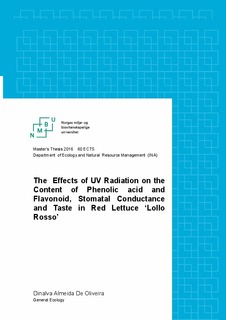The effects of UV radiation on the content of phenolic acid and flavonoid, stomatal conductance and taste in red lettuce 'Lollo Rosso'
Master thesis
Permanent lenke
http://hdl.handle.net/11250/2403132Utgivelsesdato
2016-08-31Metadata
Vis full innførselSamlinger
- Master's theses (INA) [593]
Sammendrag
The use of supplementary light to improve the quality of red lettuce is common practice in today’s greenhouse production. Fluorescent lamps that emit Ultraviolet (UV) radiation have been shown to increase the synthesis of phenolic acids and flavonoids as well to control stomata movements in red lettuce. In the work presented here, I ran experiments which showed that the use of UV treatments lead to higher concentrations of these health-promoting compounds. The objective was to evaluate the effects of UV radiation on the synthesis of phenolic acids and flavonoids, as well as the stomatal conductance in red lettuce ‘Lollo Rosso’. The plants were cultivated for 30 days under irradiation from HPS lights. They were then subjected to 7 days of UV treatment: Control (PAR), UV-A (PAR+UV-A) or UV-A+B (PAR+UV-A/UV-B). After the treatment, the stomatal conductance was measured and the chemical composition of the leaves was determined using high-performance liquid chromatography (HPLC). Subsequently, a sensory analysis was conducted in order to determine whether the UV treatment lead to a bitter taste in the red lettuce. The HPLC analyses showed that the PAR+UV-A/UV-B treatment gave the highest content of phenolic acids and flavonoids and also produced the most bitter lettuce. The plants under the PAR treatment had the lowest levels of phenolic acid and flavonoids and were considered to be the best tasting. Quercetin was the main flavonoid compound in the leaves, while chicoric acid and chlorogenic acid were the most prevalent phenolic acids. Overall, the mature leaves had higher levels of these compounds than the younger leaves. Furthermore, there was a statistically significant difference in stomatal conductance between the three treatments. The results indicate that the PAR+UV-A/UV-B treatment in greenhouses may induce higher concentrations of phenolic acids and flavonoids, with no detriment to stomatal conductance in red lettuce. Unfortunately the same treatment also leads to an undesirable bitter taste.
